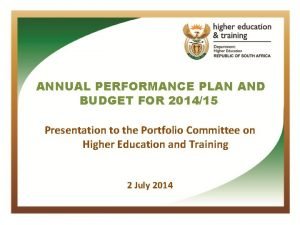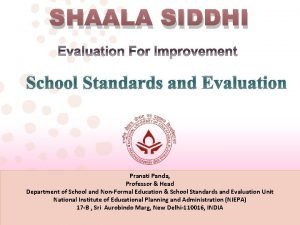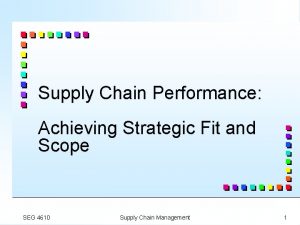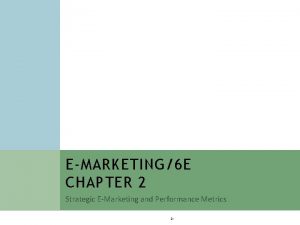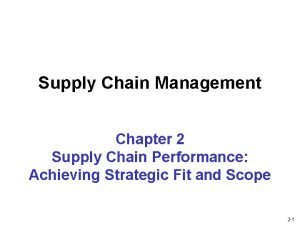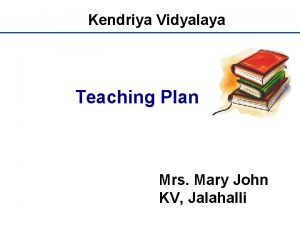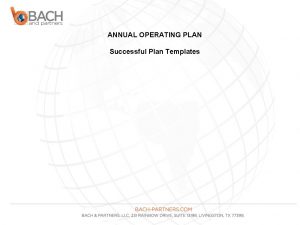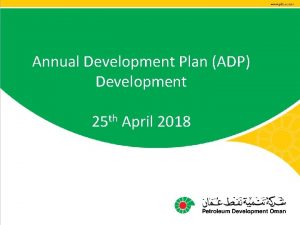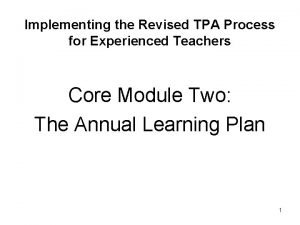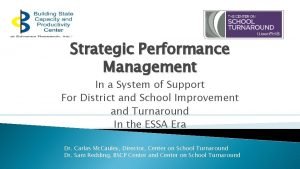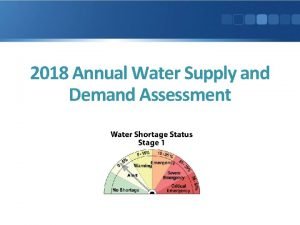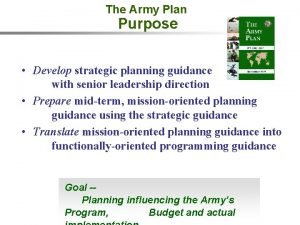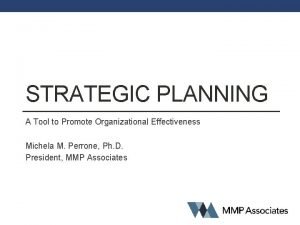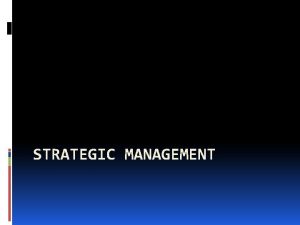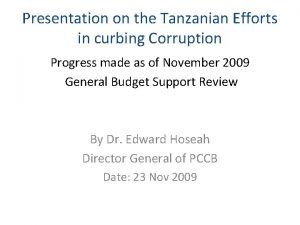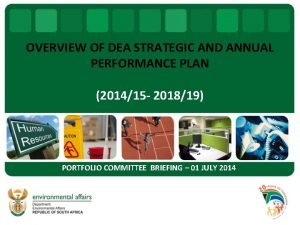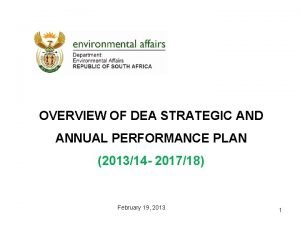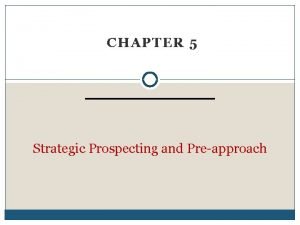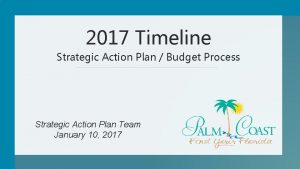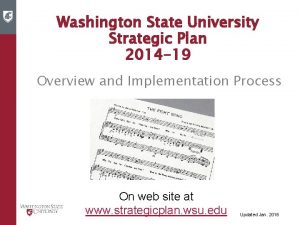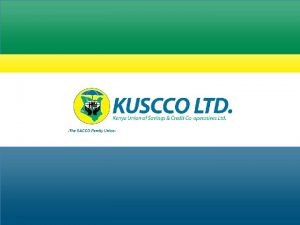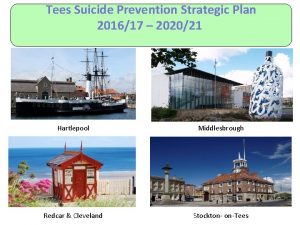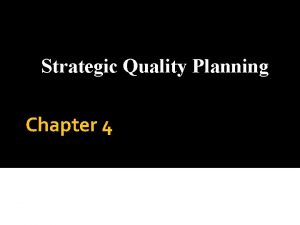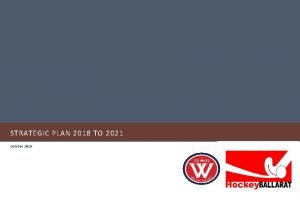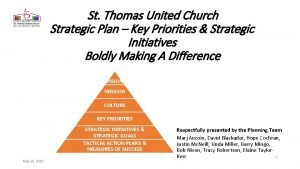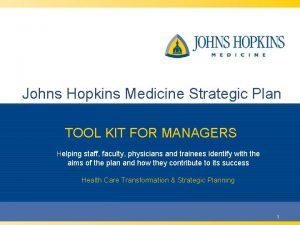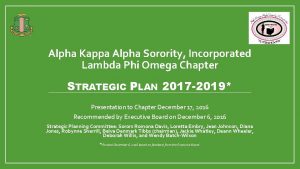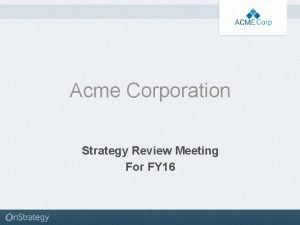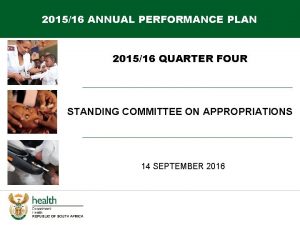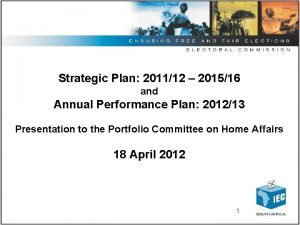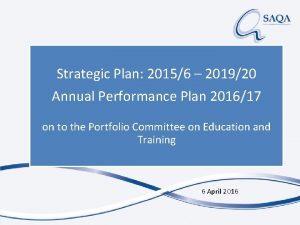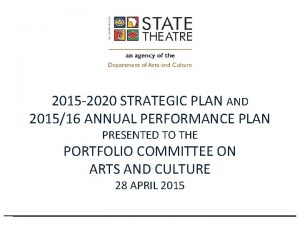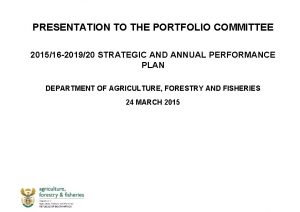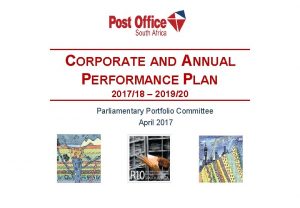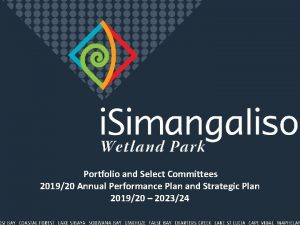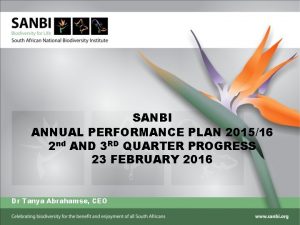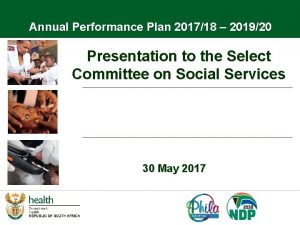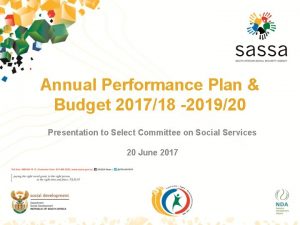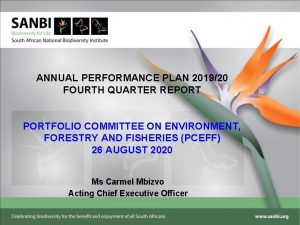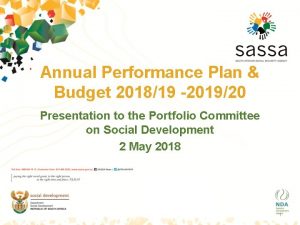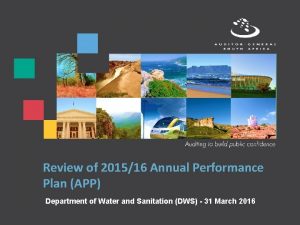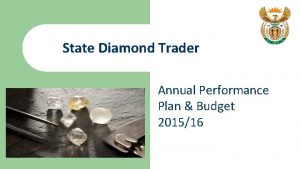STRATEGIC PLAN 201516 201920 and ANNUAL PERFORMANCE PLAN

























































- Slides: 57

STRATEGIC PLAN (2015/16 – 2019/20) and ANNUAL PERFORMANCE PLAN (2015/16 MTEF) Presentation to the Select Committee on Education and Recreation 29 April 2015

Presentation Outline 1. Strategic Overview 2. Budget Programmes and Financial Information 3. Programme Plans and Targets for 2015/16 - Administration - Human Resource Development, Planning and Monitoring Coordination - University Education - Vocational and Continuing Education and Training - Skills Development 2

Strategic Overview • The Department of Higher Education and Training is responsible for all post-school education and training in the country • It is the coordinating Department for Outcome 5 of government’s 14 outcomes “A skilled and capable workforce to support an inclusive growth path” • In 2014, the Department released a White Paper for Post. School Education and Training (PSET) • The White Paper has created a framework that defines the Department’s vision for PSET, its focus and priorities • The Strategic Plan covers the period 2015 to 2020 and is informed by the vision espoused in the National Development Plan, 2014 - 2019 Medium Term Strategic Framework (MTSF) and imperatives of the White Paper. 3

Strategic Overview Vision Leading Post-School Education and Training for growth Mission To provide national strategic leadership in support of an integrated Post-School Education and Training system towards improved quality of life of the South African citizenry 4

Five Year Strategic Goals • Strategic Goal 1: To provide a sound Post-School Education and Training legislative framework • Strategic Goal 2: To provide Post-School Education and Training services • Strategic Goal 3: To provide Post-School Education and Training capacity • Strategic Goal 4: To facilitate a strong stakeholder network • Strategic Goal 5: To ensure continuous business excellence within the Department of Higher Education and Training 5

Five Year Strategic Goals In line with the strategic goals identified, we will: • Develop and review legislative frameworks aimed at steering the Post-School Education and Training system in line with the imperatives of the White Paper • Strive to expand improve the quality of Post-School Education and Training by introducing appropriate teaching and learning support interventions for Universities and Technical and Vocational Education and Training (TVET) colleges, as well as artisan development • Establish, develop and expand a new institutional type – Community Colleges – primarily to promote education and training opportunities for those young people who cannot access the universities or TVET colleges 6

Five Year Strategic Goals • Improve the capacity of the system through infrastructure development for technical and vocational education and training • Maintain good stakeholder relations in support of an effective Post-School Education and Training system • Ensure good corporate governance including efficient resource management within the Department and its entities. 7

Focus Areas in the Next Five Years • To substantially expand access to education and training for youth and adults, regardless of whether or not they have completed school • To improve the alignment between universities, TVET colleges, Sector Education and Training Authorities (SETAs), South African Qualifications Authority (SAQA) and quality councils in an effort to improve student and learner mobility across institutions and qualifications • To expand the availability of opportunities for workplace training for students in colleges and universities and to expand other forms of workplace training such as learnerships and apprenticeships 8

Focus Areas in the Next Five Years • To ensure that our Post-School Education and Training system prioritises funding of the marginalised, enabling them to access post-school institutions and fulfill dreams of careers thought to be unrealisable • To further develop post-graduate studies to ensure the expansion of the academic profession and development of high level knowledge and skills • To diversify provision based on open learning principles to improve learning opportunities across the Post-School Education and Training sector by expanding and strengthening the post-school distance education landscape 9

Focus Areas in the Next Five Years • To integrate disability into the broader policy arena by introducing a national policy to guide education and training institutions in the post-school domain • To integrate Recognition of Prior Learning (RPL) into the post-school education and training system 10

Financial Information The financial information of the Department is presented as follows: § § An explanation of the Department’s structure, budget and expenditure trends A summary of the allocations per programme over the 2015 Medium-Term Expenditure Framework (MTEF) A summary per economic classification that covers the key expenditure items Key budget pressures that are facing the Department’s financial performance 11

Structure, Budget and Expenditure Trends The Department’s budget structure is based on its organisational structure and consists of five programmes that represent Branches in the Department. The programmes are as follows: 1) Administration Provide strategic leadership, management and support services to the Department 2) Human Resource Development, Planning and Monitoring Coordination Provide strategic direction in the development, implementation and monitoring of Departmental policies and the Human Resource Development Strategy of South Africa 12

Structure, Budget and Expenditure Trends 3) University Education Develops and coordinates policy and regulatory frameworks for an effective and efficient university education system. The Branch also provides financial support to universities, the National Student Financial Aid Scheme (NSFAS) and national institutes for higher education 4) Vocational and Continuing Education and Training Plans, develops, monitors, maintains and evaluates national policy, programmes, assessment practices and systems for vocational and continuing education and training including for TVET colleges and post-literacy Adult Education and Training (AET) 13

Structure, Budget and Expenditure Trends 5) Skills Development Promotes and monitors the national skills development strategy. Develops a skills development policy and regulatory framework for an effective skills development system 14

Structure, Budget and Expenditure Trends • The budget also includes “direct charges” which are amounts reflected that constitute a direct commitment from the National Revenue Fund in terms of specific legislative requirements and are not defined as Voted funds such as for the above five programmes • The “direct charge” for the Department is the skills levy revenue collected by the South African Revenue Service (SARS) for the Sector Education and Training Authorities (SETAs) and the National Skills Fund (NSF) 15

Structure, Budget and Expenditure Trends • For the 2015 MTEF, the Department’s budget (excluding direct charges) increases at an annual average rate of 5. 9%, from R 39. 0 billion in 2014/15 to R 46. 3 billion in 2017/18 • The amount of R 41. 8 billion for 2015/16 is an increase of R 2. 9 billion (nominal increase of 7. 3%) on the 2014/15 allocation, excluding direct charges • Direct charges (the skills levies for SETAs and NSF), increases at an annual average rate of 9. 6% from R 13. 2 billion in 2014/15 to R 17. 4 billion in 2017/18 • The Department’s budget is dominated by Programme 3: University Education, which represents 78. 5% of the budget in 2015/16 (See slide 20). As a result, transfer payments also dominate the budget in terms of the economic classification of expenditure (See slide 21) 16

Structure, Budget and Expenditure Trends • Normal Departmental services (excluding university transfers, transfers to public entities, Technical and Vocational Education and Training colleges, Adult Education and Training centres, other organisations and earmarked funds) represents 18. 67% of the budget • Compensation of employees amounts to R 7 308. 192 million (17. 5%) for 2015/16. Remaining funds for operations amounts to R 505. 310 million in 2015/16 which represents 1. 21% of the budget 17

Structure, Budget and Expenditure Trends • The Department received an additional allocation of R 15. 9 billion over the MTEF. These additional funds are mainly for the following purposes: § R 7 billion from the Provincial Education (provincial equitable share) for the TVET and the AET colleges function shift (R 2. 22 billion in 2015/16, R 2. 34 billion in 2016/17 and R 2. 4 billion in 2017/18) § R 8. 9 billion from the TVET conditional grants to provincial government for the TVET colleges function shift from provincial to national (R 2. 8 billion in 2015/16, R 3 billion in 2016/17 and R 3. 1 billion in 2017/18) 18

Funding of TVET and AET Functions Reconciliation 2015/16 R’ 000 Additional allocation: Function shift from Provincial Education (provincial equitable share) for AET and TVET 2 215 483 TVET colleges funds shifted from Provincial Conditional Grants to National 2 818 573 TVET subsidies 3 361 001 Total 8 395 057 Distribution of funding Compensation of Employees • Administration (Finance/HR/GITO/Legal Services, etc. ) • TVET college staff (including Principals and Deputy Principals) • TVET college support staff • AET support staff • TVET and AET (SETA Levies for Internship Programme) • AET Examiners and Moderators 6 853 306 45 017 4 974 913 53 409 1 607 904 122 916 9 112 40 035 19

Funding of TVET and AET Functions Goods and Services Additional allocation R’ 000 322 705 • Administration (Finance/HR/GITO/Legal Services, etc. ) 50 558 • TVET sector 95 367 • AET sector 113 967 • TVET and AET (SETA levies for Training) 22 781 • AET Examinations 40 032 Machinery and Equipment 8 891 • Administration (Finance/HR/GITO/Legal Services, etc. ) 5 817 • AET sector 3 074 Transfers and subsidies • Administration (SETA levies) • TVET subsidies 1 210 155 134 1 140 945 • AET transfers 55 408 • SETA levies 13 668 20

Financial Information Programme Adjusted Appropriation 2014/15 Administration Human Resource Development, Planning and Monitoring Coordination University Education Vocational and Continuing Education and Training Skills Development Subtotal Direct charge against the National Revenue Fund Total Medium-Term Expenditure Estimate R’ 000 2015/16 2016/17 2017/18 285 674 318 330 952 347 528 54 726 54 843 57 786 60 728 30 443 748 32 844 325 34 602 909 36 342 892 8 098 008 8 515 770 8 985 880 9 439 257 106 300 110 699 116 719 126 615 38 988 456 41 843 955 44 094 246 46 317 020 14 690 000 16 140 000 17 400 000 56 533 955 60 234 246 63 717 020 13 200 000 52 188 456 21

Financial Information Economic classification Adjusted Appropriation 2014/15 Medium-Term Expenditure Estimate R’ 000 2015/16 2016/17 7 009 016 7 308 192 7 732 509 8 137 676 301 877 492 984 501 224 513 933 31 672 509 34 030 453 35 852 829 37 658 183 6 138 832 6 448 551 6 810 674 7 151 208 120 864 117 424 120 961 139 806 173 13 981 14 767 15 500 24 155 093 26 243 227 27 634 118 29 015 824 1 148 072 1 140 945 1 202 470 1 262 514 0 55 408 58 344 61 261 Higher Education South Africa for HEAIDS project 7 420 7 761 8 172 8 581 Commonwealth of Learning and IBSA 2 915 3 156 3 323 3 489 99 140 - - - 5 054 12 326 7 684 7 228 Compensation of Employees Goods and Services Transfers and subsidies National Student Financial Aid Scheme Public entities (SAQA, CHE, QCTO) SETA transfers (DHET’s contribution) Universities TVET Colleges (Subsidies) Adult Education and Training Centres Other (Leave gratuity) Payments for capital assets Subtotal Direct charge against the National Revenue Fund Total 38 988 456 13 200 000 52 188 456 2017/18 41 843 955 44 094 246 46 317 020 14 690 000 16 140 000 17 400 000 56 533 955 60 234 246 63 717 020 22

Key Budget Pressures Facing the Department • The Department acknowledges the current fiscal constraints of Government • This has numerous challenges in itself, but also has a serious impact on the service delivery requirements of the Department • The Department is unable to attain the growth requirements within the post-school education system in terms of enrolments, infrastructure development, increased operations and student support • Limitations are placed on Departmental operations due to the capping of compensation of employees and the inability to roll out the new staff establishment and regional presence 23

Key Budget Pressures Facing the Department • Institutional monitoring and evaluation is limited to most critical areas • Reliance on NSF project support such as the funding of the activities of the National Artisan Moderation Body • An immediate pressure is the management of the TVET and AET function shift as well as cost implications for examination services 24

Financial Performance • The Department managed to remain within its budget since being in operation from 1 April 2010 • Underspending on voted funds was as follows: 2010/11: R 23. 848 million 2011/12: R 17. 817 million 2012/13: R 3. 751 million 2013/14: R 1. 931 million • Unspent amounts were committed for specific goods or services and including outstanding claims for examiners and moderators • The Department received unqualified audits to date 25

Programme 1: Administration Programme Purpose: Provide strategic leadership, management and support services to the Department Five Year Strategic Objective (1): To ensure effective human resource management within the Department by filling 90% of vacant funded positions and implementation of an effective performance management system Performance Indicator 2015/16 Target Approved funded positions filled (%) 90% Disciplinary cases resolved within 90 days (%) 100% Average lead time from recruitment requisition received until appointment recommendation made (days) 180 days 26

Programme 1: Administration Five Year Strategic Objective (2): To ensure effective financial management through the application of good financial management systems, including management accounting, financial accounting and supply chain management in line with the requirements of the PFMA Performance Indicator Audit issues received versus attended to (%) Creditor payment age (days) 2015/16 Target 100% 30 days Five Year Strategic Objective: (3): To improve efficiency through the development of approved annual ICT procurement plans for the implementation of the necessary information technology infrastructure and systems Approved ICT procurement plans per annum (n) 1 27

Programme 2: Human Resource Development, Planning and Monitoring Coordination Programme Purpose: Provide strategic direction in the development, implementation and monitoring of departmental policies and the HRD strategy of South Africa 28

Programme 2: Human Resource Development, Planning and Monitoring Coordination Five Year Strategic Objective (1): To develop 8 new PSET policies and 1 legislation including the revision of the National Qualifications Framework Act and GENFETQ Act, in order to ensure a sound Post-School Education and Training System by 31 March 2020 Performance Indicator 2015/16 Target New Post-School Education (4) and Training steering • Policy and guidelines on Recognition of Prior mechanisms developed Learning (RPL) developed and gazetted and approved (n) • Policy framework on disability developed • Policy framework on social inclusion published • Policy and guidelines on articulation developed and gazetted 29

Programme 2: Human Resource Development, Planning and Monitoring Coordination Five Year Strategic Objective (2): To develop a Sector Monitoring and Evaluation Framework for effective implementation of oversight of the PSET system and produce annual monitoring reports by 31 March 2020 Five Year Strategic Objective (3): To develop and implement 3 teaching and learning support plans aimed at improving access to quality teaching and learning in the PSET system by 31 March 2020 Performance Indicator 2015/16 Target Teaching and learning (2) support plans for Post-School • Flexible model of learning delivery Education and Training Conceptualised and implementation Strategy approved (n) developed and approved • Prototype of a learning management system for open learning system developed and approved 30

Programme 2: Human Resource Development, Planning and Monitoring Coordination Five Year Strategic Objective (4): To develop management information systems for colleges and SETAs and private post-school institutions by 31 March 2020 Performance Indicator 2015/16 Target Information management (1) systems developed and “i WIL” registration system for learners approved (n) seeking work integrated learning opportunities and firms wanting to provide work integrated learning, on internet developed and approved Statistical reports published (n) (2) • Annual Report on Skills Supply and Demand published • Annual Post-School Statistical Report published 31

Programme 3: University Education Programme Purpose: Develop and coordinate policy and regulatory frameworks for an effective and efficient university education system. The Branch also provides financial support to universities, NSFAS and national institutes for higher education 32

Programme 3: University Education Five Year Strategic Objective (1): To develop 13 new and review 6 policies/regulations/pieces of legislation to ensure sound provision of university education by 31 March 2020 Performance Indicator 2015/16 Target New higher education steering mechanisms developed and approved (n) (1) Policy on the provision of student housing at SA public universities and minimum norms and standards published in the Government gazette by end of September 2015 Higher education steering mechanisms revised and published (n) (2) • Revised regulations for regulating PHEIs approved and published in the Government Gazette for implementation by September 2015 • Revised Higher Education Act promulgated by end of March 2016 33

Programme 3: University Education Five Year Strategic Objective (2): To develop 2 integrated plans that will enable collaboration between university education and other PSET sectors by March 2020 Five Year Strategic Objective (3): To monitor and evaluate the higher education sector and produce 13 annual oversight reports on the financial health of the sector; governance; teaching development; research development and productivity; HEAIDS; Foundation provisioning; Infrastructure development; New universities; Expansion and efficiency of the system; Private higher education compliance; Staffing South Africa’s Universities Framework (SSAUF); and Teaching and Learning Development Capacity Improvement Plan Performance Indicator Monitoring and Evaluation reports on higher education produced and approved (n) 2015/16 Target 12 34

Programme 3: University Education Five Year Strategic Objective (4): To develop and implement a Teaching and Learning Development Capacity Improvement Programme (TLDCIP) covering five plans to improve the capacity of universities in terms of teaching and research by March 2020, one each in the fields of: • ECD educator development • Primary teacher education • TVET college lecturer education • Community college lecturer education • Special needs teacher education Performance Indicator Teaching and learning support plans for higher education developed and approved (n) 2015/16 Target (1) Teaching and Learning Development Capacity Improvement Programme approved for implementation by the Director-General by end March 2016 35

Programme 3: University Education Five Year Strategic Objective (5): To provide support to current and prospective students in higher education institutions by March 2020 through the development and implementation of a concise capacity development strategy and programme as well as the Central Applications Services Performance Indicator 2015/16 Target Student support services plans for (2) higher education institutions developed • Student Leadership capacity and approved (n) development strategy and programme developed and implemented by October 2015 • Enterprise Architecture for the Central Applications Service developed and approved by March 2016 36

Programme 3: University Education Five Year Strategic Objective (6): To produce and publish an annual first time entering undergraduate cohort analyses report annually Performance Indicator 2015/16 Target Cohort study reports on higher education published per annum (n) (1) 2005 to 2008 First time entering undergraduate cohort analyses report published on the DHET website by March 2016 Five Year Strategic Objective (7): To facilitate stakeholder network through the establishment of a BRICS think tank and participative academic forum and report progress on partnerships annually Partnership reports produced and approved per annum (n) (1) A Report on the 2015 BRICS Academic forum and Think Tank partnerships approved by Minister by March 2016 37

Programme 3: University Education Expected outcomes to be monitored and reported by the programme Performance Indicator Baseline (2012 academic year) 2015/16 Target (2013 academic year) Students enrolled in public higher education studies at universities (n) 950 000 100 Success rates at universities (%) 76% Graduates in Engineering Sciences from universities (n) 9 974 10 100 Graduates in initial Teacher Education from universities (n) 13 740 17 500 New indicator 100% 6 076 6 200 Proportion of universities meeting standards of good governance (%) Research Masters graduates (n) 38

Programme 3: University Education Expected outcomes to be monitored and reported by the programme Performance Indicator Baseline 2015/16 Target New indicator 3 38% 42% New indicator 100 First year students in foundation programmes (n) 16 300 23 902 Eligible university students obtaining financial aid (n) 194 504 205 000 Graduates in Human Health and Animal Health from universities (n) 8 015 9 000 Universities offering accredited TVET college qualifications (n) University academic staff with PHDs (%) Additional first-time entrants (black and women) to academic workforce in addition to normal replacement and plans (n) 39

Programme 3: University Education Expected outcomes to be monitored and reported by the programme Performance Indicator Baseline 2015/16 Target Graduates in Natural and Physical Sciences from universities (n) 6 366 6 600 Higher education undergraduate success rates (contact) (%) 79% 80% Higher education undergraduate success rates (distance) (%) 69% 71% 40

Programme 4: Vocational and Continuing Education and Training Programme Purpose: Plan, develop, monitor, maintain and evaluate national policy, programmes, assessment practices and systems for vocational and continuing education and training including for TVET colleges and post-literacy adult education and training 41

Programme 4: Vocational and Continuing Education and Training Five Year Strategic Objective (1): To develop 6 and revise 5 legislative and guiding frameworks aimed at steering the Vocational and Continuing Education and Training sector by 31 March 2020 Performance Indicator New Vocational and Continuing Education and Training steering mechanisms developed and approved (n) 2015/16 Target (6) • Governance and policies for TVET Colleges • Staffing norms and standards for CETCs • Conduct policy for NASCA • Guidelines for standardised implementation of Occupational Programmes • Policy directives for TVET College Information Technology systems • Governance policies for Community colleges 42

Programme 4: Vocational and Continuing Education and Training Performance Indicator 2015/16 Target Vocational and Continuing Education (1) and Training steering mechanisms TVET Colleges monitoring, evaluation revised (n) and support model revised and approved Five Year Strategic Objective (2): To standardise the level of governance across VCET institutions by 31 March 2020. Monitor and take appropriate actions when deficiencies are detected Monitoring and Evaluation reports on VCET institutions produced and approved (n) 2 43

Programme 4: Vocational and Continuing Education and Training Performance Indicator 2015/16 Target Five Year Strategic Objective (3): To develop and implement 6 teaching and learning support plans for VCET institutions by 31 March 2020 Annual teaching and learning support plans for Vocational and Continuing Education and Training developed and approved (n) (2) • Protocol on the secondment of sector specialists to work in TVET Colleges and lecturers exposed to the work place developed and approved • Annual teaching and learning support plan for VCET system developed and approved 44

Programme 4: Vocational and Continuing Education and Training Performance Indicator 2015/16 Target Five Year Strategic Objective (4): To improve success in programmes offered in VCET institutions by developing and implementing appropriate student support plans by 31 March 2020 Annual student support services plans for Vocational and Continuing Education and Training developed and approved per annum (n) 1 45

Programme 4: Vocational and Continuing Education and Training Performance Indicator 2015/16 Target Five Year Strategic Objective (5): To ensure geographic spread of VCET institutions through the establishment of 21 additional sites of delivery for VCET institutions (12 TVET college campuses and 9 CETCs) by 31 March 2020 Macro infrastructure and maintenance plan for CETCs developed (n) VCET sites/facilities established (n) 1 6 TVET college campuses built: • Mpumalanga 1 site • Eastern Cape 2 sites • Kwa. Zulu-Natal 3 sites Five Year Strategic Objective (6): To establish a coordinating structure for support and research in the VCET sector by 31 March 2020 Strategy on strategic partnerships with key stakeholders developed and approved (n) 1 46

Programme 4: Vocational and Continuing Education and Training Performance Indicator Baseline 2013/14 2015/16 Target Headcount enrolments in TVET colleges (n) 670 455 725 000 Certification rates in TVET qualifications (%) NC (V) L 4: 37% N 3: 51% N 6: 41% NC (V) L 4: 59% N 3: 53% N 6: 53% Lead time to issue certificates to qualifying candidates (months) 12 months 9 months Percentage of public TVET college examination centres conducting national examinations and assessments in compliance with national policy (%) 70% 100% TVET throughput rate (%) New indicator 10% 47

Programme 4: Vocational and Continuing Education and Training Performance Indicator Baseline 2015/16 Target Students accommodated in public TVET colleges (n) New indicator 1 000 Qualifying TVET students obtaining financial assistance (n) 273 679 200 000 Funded NC(V) L 4 students obtaining qualification within stipulated time (%) New indicator 10% TVET institutions compliant to governance standards by 2019 and increasing every year thereafter (%) New indicator 20% TVET lecturers undergoing specified hours of work in their industry for specified periods every two years from 2019 (%) – as per APP New indicator 6% 48

TVET College Budget Allocation Province 2014/15 2015/16 ‘ 000 % share Eastern Cape 838 630 879 951 14% Free State 389 424 410 955 7% Gauteng 1364 872 1 447 975 23% Kwa. Zulu-Natal 1033 932 1 099 995 18% Limpopo 657 723 700 604 11% Mpumalanga 413 864 439 830 7% 94 427 101 368 2% North West 314 409 334 768 5% Western Cape 719 892 764 128 12% TOTAL 5 827 173 Average Baseline Growth Rate from 2014 to 2015 6 179 574 100% 6. 0% Northern Cape 49

TVET Colleges Bursary Allocation Province 2014/15 ‘ 000 2015/16 ‘ 000 % share Eastern Cape 227 212 237 981 11% Free State 148 253 154 665 7% Gauteng 467 933 488 707 22% Kwa. Zulu-Natal 447 349 467 891 21% Limpopo 281 502 294 618 13% Mpumalanga 129 184 135 107 6% 43 215 45 182 2% North West 135 579 141 667 6% Western Cape 227 510 238 182 11% 2 107 737 2 204 000 100% Northern Cape TOTAL Average Baseline Growth Rate from 2014 to 2015 5% 50

Programme 5: Skills Development Programme Purpose: Promote and monitor the national skills development strategy. Develop a skills development policy and regulatory framework for an effective skills development system. 51

Programme 5: Skills Development Performance Indicator 2015/16 Target Five Year Strategic Objective (1): To steer and support skills development institutions to implement the National Skills Development Strategy through the development of 4 new and 6 revised policies including legislation, regulations and guidelines by 31 March 2020 New skills development (4) steering mechanisms • Workplace based learning policy developed and approved (n) and approved by Director-General by December 2015 • Governance charter for SETA’s developed and approved by March 2016 • Occupational team policy recommendation tabled by December 2015 • SETAs Governance standards developed and approved by the Director-General 52

Programme 5: Skills Development Performance Indicator 2015/16 Target Skills development Steering (2) mechanisms revised (n) • SETA landscape reviewed and approved by the Minister by March 2016 • A reviewed National skills development Strategy approved by the Minister by March 2016 Five Year Strategic Objective (2): To standardise the level of governance across Sector Education and Training Authorities (SETAs) by 31 March 2020, monitor and compile annual quarterly reports and take appropriate actions where deficiencies are detected SETA monitoring reports on skills development produced and approved (n) 4 53

Programme 5: Skills Development Performance Indicator 2015/16 Target Five Year Strategic Objective (3): To effectively manage artisan development assessment services inclusive of RPL in order to produce 24 000 qualified artisans per annum by 31 March 2020 Average lead time from trade test application received until trade test conducted (days) 100 days New artisan learners registered nationally per annum (n) 29 750 New artisans qualified per annum (n) 20 110 National artisan learners pass trade test rate (including INDLELA) (%) 50% 54

Programme 5: Skills Development Performance Indicator 2015/16 Target Five Year Strategic Objective (4): To enhance the National Information System in order to improve collation of artisan information and skills development levy information for monitoring and evaluation as well as reporting by 31 March 2018 Information management systems developed (n) A single national artisan development information management system designed and approved 55

Programme 5: Skills Development Expected outcomes to be monitored and reported by the programme Performance Indicator Baseline 2015/16 Target 49 678 45 000 45% 50% National artisan learners employed or selfemployed (%) 65% (HSRC research report) 67% Proportion of SETAs meeting standards of good governance (%) New indicator 100% Work based learning opportunities (n) National artisan learners pass trade test rate (including INDLELA) (%) 56

Thank You
 Annual performance plan
Annual performance plan Shaala siddhi
Shaala siddhi Complements and substitutes
Complements and substitutes Industrial organization model of above average returns
Industrial organization model of above average returns Strategy analysis and choice largely involves making
Strategy analysis and choice largely involves making Zone of strategic fit in supply chain
Zone of strategic fit in supply chain Performance management and strategic planning
Performance management and strategic planning Chapter 2
Chapter 2 Supply chain performance achieving strategic fit and scope
Supply chain performance achieving strategic fit and scope Strategic e-marketing and performance metrics
Strategic e-marketing and performance metrics Strategic fit vs strategic intent
Strategic fit vs strategic intent Annual implementation plan
Annual implementation plan Lesson plan kvs bangalore region
Lesson plan kvs bangalore region Annual operating plan template
Annual operating plan template Definition of career aspirations
Definition of career aspirations Annual learning plan examples
Annual learning plan examples Annual learning plan ideas for teachers
Annual learning plan ideas for teachers Grade 11 annual teaching plan
Grade 11 annual teaching plan Grade 8 ems term 1 data response
Grade 8 ems term 1 data response Strategic management performance system
Strategic management performance system Bars rating scale
Bars rating scale Performance levels
Performance levels Jcids manual
Jcids manual Retail goals
Retail goals Annual water supply and demand assessment
Annual water supply and demand assessment Sachs immuno oncology bd&l and investment forum
Sachs immuno oncology bd&l and investment forum Present worth vs annual worth
Present worth vs annual worth Annual review of pharmacology and toxicology
Annual review of pharmacology and toxicology Nhgri strategic plan
Nhgri strategic plan Types of corporate strategy
Types of corporate strategy The army plan
The army plan Strategic implementation plan
Strategic implementation plan Bank of america strategic goals
Bank of america strategic goals Bcg matrix disney
Bcg matrix disney Spu strategic business plan
Spu strategic business plan Rotary strategic plan
Rotary strategic plan Vission of pccb
Vission of pccb Hr shared services strategic plan
Hr shared services strategic plan Plan dea
Plan dea Dea strategic plan
Dea strategic plan Howard university strategic plan
Howard university strategic plan Sa-sams marksheets 2020
Sa-sams marksheets 2020 What is strategic prospecting
What is strategic prospecting Amway strategic plan
Amway strategic plan Acme corporation strategic plan
Acme corporation strategic plan Strategic action plan
Strategic action plan Ymca fredericton
Ymca fredericton Duties of personal ministries leader
Duties of personal ministries leader Wsu strategic plan
Wsu strategic plan Sacco strategic plan
Sacco strategic plan Tees strategic plan
Tees strategic plan Strategic quality planning
Strategic quality planning Strategic plan 2018 to 2021
Strategic plan 2018 to 2021 Church strategic plan doc
Church strategic plan doc Personal ministries strategic plan
Personal ministries strategic plan Johns hopkins strategic plan
Johns hopkins strategic plan Aka sorority mission statement
Aka sorority mission statement Acme corporation strategic plan
Acme corporation strategic plan
